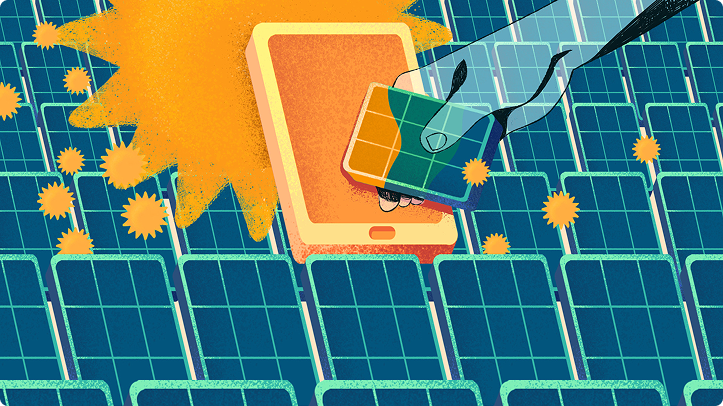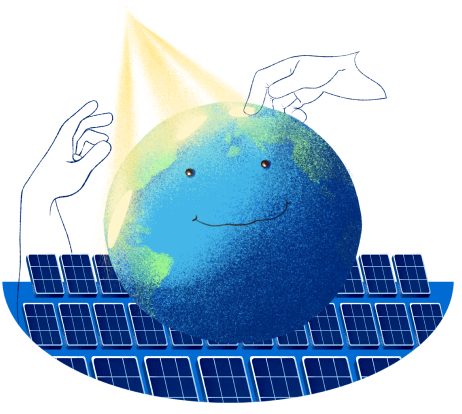India crossed its 40 GW rooftop solar goal recently in 2022. Beyond a goal line and metric, what this means is that rooftop solar is becoming a frequent addition to many houses across the country. As more people are transitioning to solar, it’s important for those considering doing so as well to understand the solar panel installation process and the various factors around it first. Let’s get started.
Home Solar Panel Installation Process Explained with Key Considerations
-
Basic solar system components:
Solar panels, charge controller, inverter/UPS, and optional battery (if not grid-connected).
-
Installation process:
Includes setting up of mounts & installing modules, connection of the system to a solar inverter, and linkage of the solar inverter with the grid.
-
Pre-installation considerations:
Electricity required for the household, amount of sunlight & climate conditions in the area, size & type of panels, grid or off-grid system.
-
Costs depend on:
Overall expenses will be variable based on policy in states, subsidy availed, labour cost in the state, etc.
What You Need for a Solar Panel Setup
Here are the core components typically required for a home solar panel installation:
-
Solar Panels:
Solar panels or photovoltaic cells are the main components, or we can say the backbone, of the solar power system. There are some types of solar panels, such as polycrystalline and monocrystalline. The selection criteria for a solar panel are different, that is, space, efficiency, and cost.
-
Charge Controller:
A charge controller is a device that is used to regulate the voltage and current from solar panels connected to the batteries or an inverter.
-
Inverter / UPS:
An inverter is a device that converts a DC power supply into an AC power supply. Inverters and converters are also known as UPS (uninterrupted power supply).
-
Battery (Optional for Grid-Connected Systems):
Batteries are used for backup charge storage. There are different types of batteries used in a solar system for backup and storage systems overnight, as direct power is not available from sunlight.
The Solar Panel Installation Process
-
Step 1: Setting Up the Mounts and Installing Modules:
The first step is to fix the mount that will support the solar panel (south-facing for those in the northern hemisphere and vice versa). The mounting structure should be slightly tilted (around 18 to 36 degs). The angle of the tilt could be between 18 to 36 degrees. Many companies use a solar tracker to increase conversion efficiency. Once the mounts go up, the solar modules are tethered to the mount via bolts.
-
Step 2: Connecting the System to the Inverter:
The next step is to do the electrical wiring. They can be connected in series connection or parallel connection as per the required configuration to the solar inverter. The positive wire of the solar system is attached to the positive terminal of the inverter, and the negative wire is attached to the negative terminal. After that, the inverter could be connected to a solar battery or the grid through the meter.
-
Step 3: Linking the Inverter to the Grid:
When all the connections are done, it’s time to switch on the inverter and the main switch of the home. Most solar systems have a digital meter that shows the stats regarding the generation and usage of electricity. Most folks opt for a grid-connected system to maximise the use of their power system and also as an alternative to having a more expensive battery system. However, connecting with the grid requires permits and certification from your local utility.

Things to Consider Before Installing Solar Panels
If you have made up your mind about installing a solar panel System in your house, then you should consider the following factors that are involved in the solar panel installation. The following are the factors:
-
Household Electricity Needs:
Before choosing a solar power system for your home, you should consider the amount of electricity needed in your home. As a rule the more electricity you use, the more panels you need to install.
-
Sunlight and Climate Conditions:
Another critical factor is the amount of sunlight your house receives during a calendar year. The overall climate of the region and the amount of sunlight available per day is important to know the size of the installation you require.
-
Panel Type and Size
The standard size of a photovoltaic panel used in most places globally is either a 60-cell panel or a 72-cell panel. The size does not always equal efficiency; Monocrystalline panels have higher efficiency as compared to polycrystalline, and both of those have much higher efficiency as compared to thin film panels.
Grid-Connected vs Standalone Solar Systems
There are two types of residential solar systems that you might choose from: a grid-connected and a standalone power system. The latter is often referred to as an off-grid system.
As mentioned in the above section about connecting systems to the grid, most users choose a grid-connected PV system rather than a standalone photovoltaic system because it somewhat eliminates the need of having a battery system along with their panels.
Factors That Influence Solar Panel Installation Process Costs
The cost of going solar depends on:
- Type and make of solar panels.
- Inverter and battery choices.
- Local labor costs.
- Government subsidies and state-level policies.
- Permit and certification requirements.
Conclusion
Going solar isn’t just a smart choice for the planet; it can also be a great long-term investment for your home. But before making the switch, it’s important to understand the setup process, know your household energy needs, and consider local conditions and policies. Whether you’re planning to stay connected to the grid or go fully off-grid, the good news is: most of the tools and support you need are already available. And once it’s up and running, watching your meter spin backward? That’s a pretty empowering feeling.






